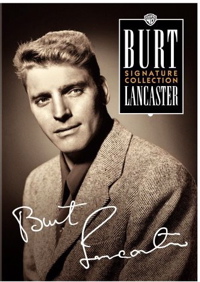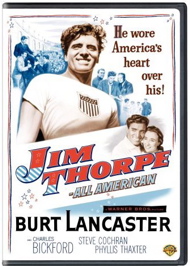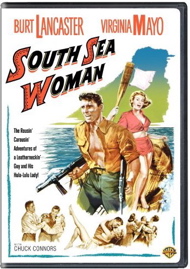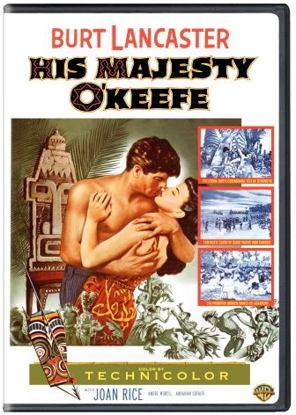| Release List | Reviews | Price Search | Shop | Newsletter | Forum | DVD Giveaways | Blu-Ray/ HD DVD | Advertise |
| Reviews & Columns |
|
Reviews DVD TV on DVD Blu-ray International DVDs Theatrical Reviews by Studio Video Games Features Collector Series DVDs Easter Egg Database Interviews DVD Talk TV DVD Talk Radio Feature Articles Columns Anime Talk DVD Savant HD Talk Horror DVDs Silent DVD
|
DVD Talk Forum |
|
|
| Resources |
|
DVD Price Search Customer Service #'s RCE Info Links |
|
Columns
|
 |
Burt Lancaster The Signature Collection |

|
Burt Lancaster The Signature Collection The Flame and The Arrow, Jim Thorpe - All American, South Sea Woman, His Majesty O'Keefe, Executive Action Warner DVD Color and B&W 1:33 flat full frame and1:78 anamorphic widescreen Street Date October 23, 2007 Starring Burt Lancaster |
Burt Lancaster The Signature Collection rounds up four early 1950s programmers and one odd effort from 1973. We start by watching Lancaster establish himself as a Hollywood superman, an athletic dervish making the most of his considerable physical agility. Lancaster alternated these action roles with more prestigious projects: Come Back, Little Sheba, From Here to Eternity. He also partnered with Harold Hecht in a producing venture (Apache, Vera Cruz) and even tried directing, with The Kentuckian.

1950 saw Burt Lancaster breaking with the film noir roles he'd begun at Universal four years before in his debut picture The Killers. The Flame and The Arrow is his first costume epic, and Warners' obvious intention is to hand Lancaster the swashbuckling torch carried by Errol Flynn. Lancaster plays Dardo Bartoli, a medieval peasant in Northern Italy who reluctantly joins the resistance against a Germanic occupier. The lavish Technicolor production was directed by the sensitive Jacques Tourneur, who manages to make us care about Dardo's central problem. Wife Francesca took off a few years back to marry Count Ulrich, the local warlord (Frank Allenby), and to hold Dardo in check Ulrich seizes Dardo's spirited son Rudi (Gordon Gebert). Dardo warms up to the Prussian princess Anne de Hesse (Virginia Mayo), whom Ulrich plans to marry off to a local Marchese, (Robert Douglas).
Dardo is soon playing Robin Hood (or William Tell?), sneaking into Ulrich's castle and engaging in entertaining acrobatic feats with his smaller companion Piccolo (Nick Cravat). The movie was likely written to exploit Lancaster and Cravat's stunts, as the two started in show business together as circus performers. Cravat became a favorite sidekick hero; his characters here and in the follow-up The Crimson Pirate were written as mutes, the better to cover up Cravat's Brooklyn accent.
Several major action scenes later, The Flame and The Arrow resolves as do all fantasy swashbucklers. Lancaster and Mayo are charming in their undemanding roles while talents like Aline McMahon are under-used. Norman Lloyd's minstrel has the film's choicest line, when Ulrich's men attack some performers. Lloyd calls to the rest of the troupe: "You aren't going to let them do that to actors, are you?" The tone is light, but not as comic-book satirical as The Crimson Pirate two years later. Screenwriter Waldo Salt would log one more credit before enduring several years on the blacklist.

In the 1960s, Jim Thorpe - All American seemed to play on TV screens more often than Them!, and we'd just keep going back to watch it again ... or at least watch the first half again. Easily the best-directed picture in this collection, it displays Michael Curtiz' immediately recognizable personal style: sharp pacing, economic, expressive shots.
This is the movie that best showcases Burt Lancaster's natural athleticism. He must be the healthiest, most all-around poised human specimen of the 20th Century. The movie's sense of vitality made even non-athletes like 13 year-old Savant want to run through the neighborhood jumping hedges; Lancaster is a natural Superman. When the writers and director of Superman: The Movie needed a visual shorthand to express the magic of the teenaged Clark Kent, they borrowed young Jim Thorpe's overland dash, and his prowess at kicking field goals. I tell ya, the film makes you want to jump up and do some push-ups.
Young Billy Gray took time out from playing Klaatu's best pal in The Day the Earth Stood Still to be Jim Thorpe as a schoolboy, coached by his father (Nestor Paiva) to make something of himself in the Indian Affairs school system. Magically transformed into Burt Lancaster at Carlisle College, Thorpe undergoes sort of a Buster Keaton/College experience, catching the eye of coach Glenn "Pop" Warner (Charles Bickford) as he runs rings around the school's track stars. Whatever game Thorpe tries, he dominates, and he eventually goes to Sweden for the 1912 Olympics, winning a batch of gold medals.
That's where the film takes its downturn, for the real Jim Thorpe is practically an American tragedy. Stripped of his medals for playing nothing-league baseball, Thorpe spirals through bad pro football experiences, becomes a drunk and eventually scrapes bottom. The script strains to redeem our hero for a happy ending, but in 1951 too many people were aware of the historical facts. Thorpe died two years later. His medals were restored in 1983.
Jim Thorpe - All American calls an Indian an Indian and isn't afraid of a cliché or two -- Jim's granma has a teepee pitched in the yard of his parents' place. Yet it's unusually sensitive to Indian issues at a time when the Civil Rights movement was just getting started. Carlisle seems a great place even if it segregates the native American students from the rest of America, and the film stresses native American pride. The script is quick to point out that Thorpe's problems were not racial in nature. Although one might argue that racism played a role in his losing his medals, Thorpe unknowingly violated a hard & fast rule of the Olympic committee. Compared to modern-day doping scandals, the penalty still seems harsh.
The movie also gets to have it both ways when it comes to Jim's courtship and marriage to a non-native American. Phyllis Thaxter (Thirty Seconds Over Tokyo) is Margaret Miller, a co-ed with a crinkly-cute nose. She catches Jim's eye, and the film makes the most of their impossibly reserved courtship. When he wants to join the seated Margaret, Jim sits on the floor next to her chair. (Spoiler) The film probably found approval from racists unaccepting of mixed marriages because Jim's marriage ends in tragedy and failure -- neither the union nor its child survives.
Steve Cochran and comic Dick Wesson provide excellent support as do the native American members of the cast. What we remember, of course, is the splendid sight of Jim Thorpe sticking out his chest proudly to accept those medals. Some of his records stood for over twenty years.

Savant has seen almost all Burt Lancaster's films and has found practically all of them to be entertaining winners. 1953's South Sea Woman is his least impressive movie. The fitful B&W service comedy is somewhere between a Hope & Crosby road picture and Terry and the Pirates. Lancaster plays Marine Corps Sgt. James O'Hearn, who refuses to speak at his court martial for desertion, piracy and other 'fun' charges, like sinking a Shanghai nightclub. O'Hearn's 'South Seas babe' Ginger Martin (Virginia Mayo again, in fine humor) tries to defend him, relating the tale of how O'Hearn and his brawling buddy Pvt. Davey White (Chuck Connors, in what may be his first highly visible role) were cast adrift on the high seas just before Pearl Harbor. While visiting Lillie Duval's tropical 'social house', the Marines came into conflict with Vichy French and German villains.
The movie is a string of fistfights and comic double-crosses. Ginger shifts her allegiance to Sgt. O'Hearn and the sneaky Vichy police chief gets popped on the head at least three times. The whole affair shapes up as a morale/enlistment piece for the Marine Corps, which means that every woman alive is hungry for the company of a Marine. The concluding high-seas battle pits a cannon-equipped yacht against a couple of Japanese destroyers. A cynic might wonder if South Sea Woman were some kind of duty Lancaster had to perform to prove his patriotism to Jack Warner after the assertive liberalism of Jim Thorpe. While the action is okay and some of the jokes amusing, this one is pretty forgettable. In small and thankless roles are Hayden Rorke (a prosecutor), Arthur Shields (an ex-Navy beach bum) and Strother Martin (a court spectator). Director Arthur Lubin took time off from his Universal Francis the Talking Mule comedies; his work is fine.

1954's His Majesty O'Keefe is Lancaster's most interesting Warners action film. Borden Chase and James Hill's script, from a book by Lawrence Klingman and Gerald Green, is a liberal's fantasy about colonial competition in the Third World. In the 1880s, Sea Captain David Dion O'Keefe is dumped overboard by a mutinous crew and washes ashore on the island of Yap. There he discovers that the German trading agent Tetins (André Morell) has been unsuccessful in motivating the natives to harvest copra, from which cocoanut oil can be derived. The natives aren't lazy: O'Keefe marvels that they travel hundreds of miles on the water to mine sacred stones called Fei.
Returning to Hong Kong, Dion finds an investor in dentist Sien Tang, (Philip Ahn) and makes his nephew Chou Tang (Benson Fong) his first mate. On another island, O'Keefe picks up a bride-to-be in Dalabo (Joan Rice). He helps the Yap islanders mine and transport their next load of Fei, but holds it hostage until they fill his ship with copra. One chieftain chooses to cooperate and another not, splitting the islanders into two camps. Dion declares his own trading company, appoints Tetins as his partner and returns to Hong Kong to marry Dalabo.
They return to Yap to find the notorious slaver Bully Hayes (Charles Horvath) raping and pillaging. O'Keefe defeats Hayes' pirates and is proclaimed King of the island. The Germans incite a war between the two tribal factions. Through Dalabo's unhappiness, O'Keefe begins to realize that he's made a tropical paradise into a capitalist battleground.
The political aspects of His Majesty O'Keefe imply that the Big Business of Big Nations lays waste to the beautiful corners of the earth. O'Keefe keeps on saying, "There must be some way to make these people work!" The script mostly shows Lancaster losing fights. Even when he challenges a chieftain, the contest ends in an honorable draw. Byron Haskin's punchy direction makes the most of the star's physicality, and delivers some graphic shocks. Small kids never forget the sight of a spear piercing the door of a hut, knowing that it's impaled a man standing on the other side.
His Majesty O'Keefe comes with a number of sideways and tangential stories. An altered soundtrack version exists with at least one cue by composer Robert Farnon. Even though Warners' package text mentions Farnon, the film on the disc credits Dimitri Tiomkin and all of the cues bear his distinctive sound. The many British technicians on the crew suggest that the film was produced in London and the music problem may have been a contractural or labor-law issue, as with the earlier Night and the City. The evocative singer heard over the end title sounds like she could be the vocalist of Night of the Hunter and Riders to the Stars.
The 'south seas love' story aspect connects with older classics but especially UA's 1951 Mark Robson charmer Return to Paradise, in which American Gary Cooper deals with the guilt of abandoning a Polynesian bride. His Majesty O'Keefe mounts an interesting triangle between Dion, his wife Dalabo and a native beauty, Kakofel (Tessa Prendergast). O'Keefe rewards Kakofel's 'favors' with a gold coin, which then becomes an object of dispute between the two women. Some sources say that the Jamaican-born Prendergast later became Tessa Welborn, who owned a fancy London pub and is credited with designing Ursula Andress' bikini for Dr. No.
Writer-director John Milius is on record as loving Return to Paradise and later made two 'white kings in savage lands' epics: Apocalypse Now and Farewell to the King. In 1983, O'Keefe's pirate opponent Bully Hayes was re-invented as a good guy for the cynical, comic Nate and Hayes starring Tommy Lee Jones.
The native chief challenged by O'Keefe is Archie Savage, who played again with Lancaster as the black freebooter Ballard in Vera Cruz. Savage relocated to Europe to choreograph exotic dance numbers for Sword 'n' Sandal epics; as an actor he's also the movies' first black astronaut, in Antonio Margheriti's Space Men (Assignment Outer Space). His Majesty O'Keefe has some impressive dances featuring Savage. All this becomes more complicated when one takes into account the 1990 fantasy Joe vs. The Volcano. The millionaire in that show also wants a rare natural resource from a tropical island, something called 'Boogaroo' or 'Boogarum.' Archie Savage's character name is Boogulroo. Yes, the clues are falling into place. When I link this thread to the JFK assassination, I'll let you know.

Savant was an usher at the National Theater in Westwood when National General Pictures' Executive Action opened to business that did not live up to the Sunday supplement articles. Definitely the work of Hollywood liberals, Executive Action is a proto-Oliver Stone 'possible scenario' for the John F. Kennedy assassination. The modestly budgeted film splits its running time between a group of right-wing idealogues conspiring in their mansions and a team of snipers practicing their marksmanship on moving targets. Another operative impersonates Lee Harvey Oswald, setting him up as the lone-assassin fall guy. The movie generates an uncomfortable tension between entertainment and propaganda. As even the filmmakers admit that much of their story is fiction, intelligent viewers wonder what parts of the story should be taken as fact and what parts are invented. The intent is to raise questions and encourage skepticism about the Warren Report with its one-shooter rush to judgment. We're just as likely to think that the issue is so confused, 'nobody really knows nothing.' In 1973 people talked about conspiracies, but even those who cared thought that the truth would never be known.
Burt Lancaster and Robert Ryan lob exposition at one another, establishing themselves as the kingpins behind a number of previous covert 'black ops' jobs overseas: smoothing the way for Texas oil companies by killing foreign dissidents. Will Geer's sinister Mr. Big isn't convinced until three things come to pass: JFK talks about removing troops from Vietnam, signs a Nuclear Test Ban Treaty and comes out strong for racial equality. This last issue is the clincher, as the racists played by Geer and Ryan have bizarre ideas about reducing non-white populations through war, starvation and forced sterilization.
A 'double' for Lee Harvey Oswald leaves a trail of pro-Cuba and pro-Russia arguments and arrests, while the Black Ops boys steal Oswald's rifle and use it as one corner of a triangulated ambush at Dealey Plaza. John Anderson is the Secret Service insider who makes sure the President's motorcade goes out of its way to drive into the trap, with the top down and little or no security on the route. After the killing, it's implied that Jack Ruby murders Oswald to save his own skin with the Mafia. Or did I not see something? This isn't as clear as it might be.
The movie ends with the chilling assertion that in just three years, eighteen hard witnesses to the assassination died, most of them violently. 'Reason' might suggest that by now, 44 years later, somebody should have come forward with a dying confession or proof in a safety deposit box. Executive Action convinces us that 'it ain't necessarily so.'
The film's acting is perfunctory and probably took only a few days' worth of the stars' time. The staging of other events is okay, as long as the constant presence of anachronistic cars isn't a drawback. The picture shifts between B&W and color to show newsfilm of Kennedy's arrival at Love Field and other events. Among the functional cast of creeps and killers, Ed Lauter is the leader of the assassins and Walter (Plastics!) Brooke is another conspirator. Good old Dick Miller is one of the shooters, 'repeating' his similar role from The St. Valentine's Day Massacre.
The transfers in Warners' Burt Lancaster The Signature Collection are basically okay, with reservations. The two flat B&W titles look fine and the enhanced widescreen Executive Action is cleaner and less grainy than the print shown in its initial engagements. But the two films released in Technicolor have issues. The Flame and the Arrow was filmed in true Technicolor. The transfer tries to replicate its look but the presumed composite neg source has misregistered shots (often involving dissolves) and blacks that become pools of dark blue, with distracting density fluctuations. His Majesty O'Keefe looks as though it were filmed on the earliest Eastmancolor negative and then printed in Technicolor. It suffers from the same problems, with colors that are okay on small monitors but slightly 'off' on larger screens. The hard truth in DVD is that most Technicolor titles are not going to sell in numbers sufficient to justify the expense required to restore them to their full beauty. Therefore, some of Hollywood's most beautiful films exist only in increasingly rare and fragile original Tech prints. That's why the wondrous but relatively obscure Return to Paradise is unlikely to undergo the rejuvenation it needs.
Audio on all of the titles is excellent.
The 50s films in the collection contain a variety of extras, starting with cartoons: Strife with Father (Buzzard chick left with English Sparrows), Hare We Go (Bugs Bunny, Christopher Columbus and jokes about Italians and Mexicans), Much Ado about Nutting (Squirrel tries to crack a cocoanut) and I Gopher You (ridiculously polite gophers). Each disc also has a George O'Hanlon "Joe McDoakes" short, the Richard Bare-directed comedies that are generally funnier than MGM's Pete Smith Specialties. The titles are So You're Going to Have an Operation, So You Want to Be a Paper Hanger, So You Want to Be an Heir, So You Want to Know Your Relatives and So You Want to Blow Your Brains Out. (Just Kidding.) Each film has a trailer, and Jim Thorpe has an entire Sports Movie trailer gallery. Executive Action's only 'fun' extra is an additional Burt Lancaster trailer gallery. It comes with November 22, 1963, a featurette with interview comments by Lancaster, producer Edward Lewis, Robert Ryan and writer Dalton Trumbo.
On a scale of Excellent, Good, Fair, and Poor,
Burt Lancaster The Signature Collection rates:
Movies: Jim-Thorpe: All American, His Majesty O'Keefe Excellent; The Flame and the Arrow Very Good +; South Sea Woman Good -; Executive Action I Really Don't Know.
Video: All Excellent except for Flame and O'Keefe, which are Good -
Sound: All Excellent
Supplements: See above
Packaging: Five keep cases in card sleeve
Reviewed: November 14, 2007
Reviews on the Savant main site have additional credits information and are more likely to be updated and annotated with reader input and graphics.
Review Staff | About DVD Talk | Newsletter Subscribe | Join DVD Talk Forum
Copyright © MH Sub I, LLC dba Internet Brands. | Privacy Policy | Terms of Use
|
| Release List | Reviews | Price Search | Shop | SUBSCRIBE | Forum | DVD Giveaways | Blu-Ray/ HD DVD | Advertise |





